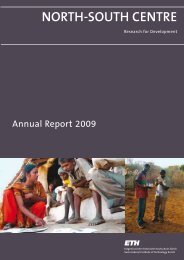Annual Report 2006/07 - ETH - North-South Centre North-South ...
Annual Report 2006/07 - ETH - North-South Centre North-South ...
Annual Report 2006/07 - ETH - North-South Centre North-South ...
Create successful ePaper yourself
Turn your PDF publications into a flip-book with our unique Google optimized e-Paper software.
ZIL research project, Phase IVProject leaderWilhelm GruissemContact personsPeng ZhangHervé VanderschurenCollaboratorsHernan Ceballos, CIAT, Colombia /Alfred Dixon, IITA, Nigeria /Linda Hanley-Bowdoin, NCSU, USA /Thomas Hohn, University of BaselDurationMarch 2003 – December <strong>2006</strong>ZIL research projectsCassavaresearchDevelopment and testing of cassava lines with improvedresistance to African Cassava Mosaic Virus (ACMV)Cassava genotype (a), geminivirus genome (b) and whitefly as vector (c)are the key components of cassava mosaic disease in Africa.abcOur project aims at developing and testing transgenic cassavaresistant to cassava mosaic disease (CMD), which is one ofthe major problems encountered in cassava fields in Africa.CMD is caused by whitefly-transmitted geminiviruses, agroup of DNA viruses with bipartite components. Synergism,recombination and pseudo-recombination between differentcassava geminivirus species have conferred these species virulencewhich has led to the recent pandemics of severe CMDin Africa. To tackle the major constraint of cassava, we developedthe RNA-mediated virus resistance in transgenic cassavavia either antisense technology or small RNAs. Finally,we expect that our technology could not only support theproof-of-concept but also provide local farmers with geminivirus-resistantlines to secure cassava production in thesubsistence farming system.In the first generation of CMD-resistant transgenic lines,antisense expression of ACMV viral genes had proven to beeffective against the virus system infection via inhibition ofits replication. These lines are about to be field-trialed inAfrica. To engineer broad-spectrum geminivirus resistance incassava, a new approach has been developed in transgeniccassava based on down-regulation of viral protein productionthrough the RNA interference (RNAi) pathway. RNAinterference is a conserved silencing mechanism whichaccounts for mRNA regulation via post-transcriptional genesilencing (PTGS) and/or transcriptional gene silencing (TGS).Transgenic cassava expressing hairpin double-stranded RNA(dsRNA) homologous to gemini-viral sequences was able tosuppress viral mRNA production, therefore leading to adecreased level of viral replication and movement in theinfected plant. We have successfully accelerated the recoveryprocess in infected cassava plants by expressing hairpindsRNA targeting the gemini-viral promoter region.Concurrently, complete resistance has been achieved intransgenic cassava expressing high levels of small RNAshomologous to the conserved region of cassava geminivirusreplication-associated protein (AC1/Rep) via an intron-containinghairpin RNA construct. The robustness of resistanceto various cassava geminiviruses will be evaluated in differentlocations in Africa.25
















